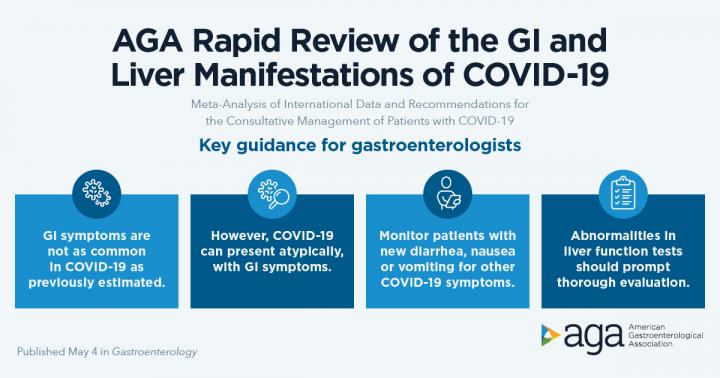AGA has published new evidence-based recommendations citing that GI symptoms are not as common in COVID-19 as previously estimated

Credit: American Gastroenterology Association
AGA has published new expert recommendations in Gastroenterology: AGA Institute Rapid Review of the GI and Liver Manifestations of COVID-19, Meta-Analysis of International Data, and Recommendations for the Consultative Management of Patients with COVID-19.
Key guidance for gastroenterologists:
- GI symptoms are not as common in COVID-19 as previously estimated: The overall prevalence was 7.7% (95% CI 7.4 to 8.6%) for diarrhea, 7.8% (95% CI: 7.1 to 8.5%) for nausea/vomiting, and 3.6% (95% CI 3.0 to 4.3%) for abdominal pain. Notably, in outpatients, the pooled prevalence of diarrhea is lower (4.0%).
- However, COVID-19 can present atypically, with GI symptoms: COVID-19 can present with diarrhea as an initial symptom, with a pooled prevalence of 7.9% across 35 studies, encompassing 9,717 patients. Most often, diarrhea is accompanied by other upper respiratory infection symptoms. However, in some cases, diarrhea can precede other symptoms by a few days, and COVID-19 may present as isolated GI symptoms prior to the development of upper respiratory infection symptoms.
- Monitor patients with new diarrhea, nausea or vomiting for other COVID-19 symptoms: Patients should inform gastroenterologists if they begin to experience new fever, cough, shortness of breath or other upper respiratory infection symptoms after the onset of GI symptoms. If this occurs, testing for COVID-19 should be considered.
- Abnormalities in liver function tests should prompt thorough evaluation: Liver test abnormalities can be seen in COVID-19 (in approximately 15% of patients); however, available data support that these abnormalities are more commonly attributable to secondary effects from severe disease, rather than primary virus-mediated liver injury. Therefore, it is important to consider alternative etiologies, such as viral hepatitis, when new elevations in aminotransferases are observed.
For all seven evidence-based recommendations and a detailed discussion, review the full publication in Gastroenterology.
###
Authors: Shahnaz Sultan, Osama Altayar, Shazia M. Siddique, Perica Davitkov, Joseph D. Feuerstein, Joseph K. Lim, Yngve Falck-Ytter, Hashem B. El-Serag on behalf of the AGA
About the AGA Institute
The American Gastroenterological Association is the trusted voice of the GI community. Founded in 1897, the AGA has grown to more than 16,000 members from around the globe who are involved in all aspects of the science, practice and advancement of gastroenterology. The AGA Institute administers the practice, research and educational programs of the organization. http://www.
About Gastroenterology
Gastroenterology, the official journal of the AGA Institute, is the most prominent scientific journal in the specialty and is in the top 1 percent of indexed medical journals internationally. The journal publishes clinical and basic science studies of all aspects of the digestive system, including the liver and pancreas, as well as nutrition. The journal is abstracted and indexed in Biological Abstracts, Current Awareness in Biological Sciences, Chemical Abstracts, Current Contents, Excerpta Medica, Index Medicus, Nutrition Abstracts and Science Citation Index. For more information, visit http://www.
AGA is now on Instagram.
Like AGA and Gastroenterology on Facebook.
Follow us on Twitter @AmerGastroAssn, AGA_Gastro.
Check out our videos on YouTube.
Join AGA on LinkedIn.
Media Contact
Courtney Reed
[email protected]




